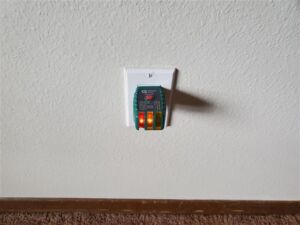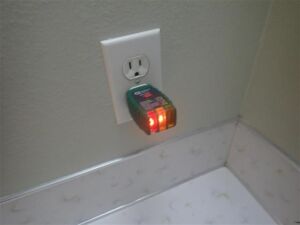
Reversed polarity occurs when an electrical outlets wiring is installed backwards (hot in the neutral screw, and neutral in the hot screw). The screws for these wires are color coded. The neutral wire should be connected to the silver screw, and the hot wire connected to the gold screw. This can happen at an individual outlet or upstream from an outlet. This improper condition is common when unqualified persons perform electrical updates in a home.
Standard outlets have two wires that carry electricity. The neutral, or grounded wire, is connected to the earth. This wire should always be white and is connected to the larger slot in an outlet. The second wire is the hot, or ungrounded wire. This wire is generally red or black and is connected to the smaller slot in an outlet. Touching a hot wire results in a shock because the hot wire completes the circuit by coming into contact with the earth, which people are on.
When an outlet is properly wired the volts from the receptacle stop at the switch when whatever is plugged in is turned off, such as a lamp. When you have a lamp plugged into a receptacle with hot and neutral wires reversed the lamp remains energized even when it is turned off at the switch. This is where the potential shock/electrocution hazard occurs. If you were to touch the light socket even while the switch is off, you could get shocked. The light will appear to be off because there is no return path for the current to flow back to the receptacle. However, it is still energized.
Toasters are another example of a potential safety hazard when plugged into a receptacle with reversed polarity. Again, even though the toaster is off, the interior components are still energized. Sticking a knife or fork into a toaster that appears to be off can result in shock or electrocution.

Fixing an outlet with reversed polarity can be relatively easy if the issue is occurring at that individual outlet. An electrician will remove the outlet and switch the wires. However, if the receptacle in question is properly wired then the issue is occurring upstream from this outlet and the electrician will need to track down the wires to locate the problem area.
Outlets with reversed polarity will appear to be functioning as intended until the opportunity for electrical shock presents itself. This is why it is important to check all the receptacles in your home to ensure they are wired correctly. Electrical repairs should be performed by qualified electrical contractors.
Check out the following video for more information:
